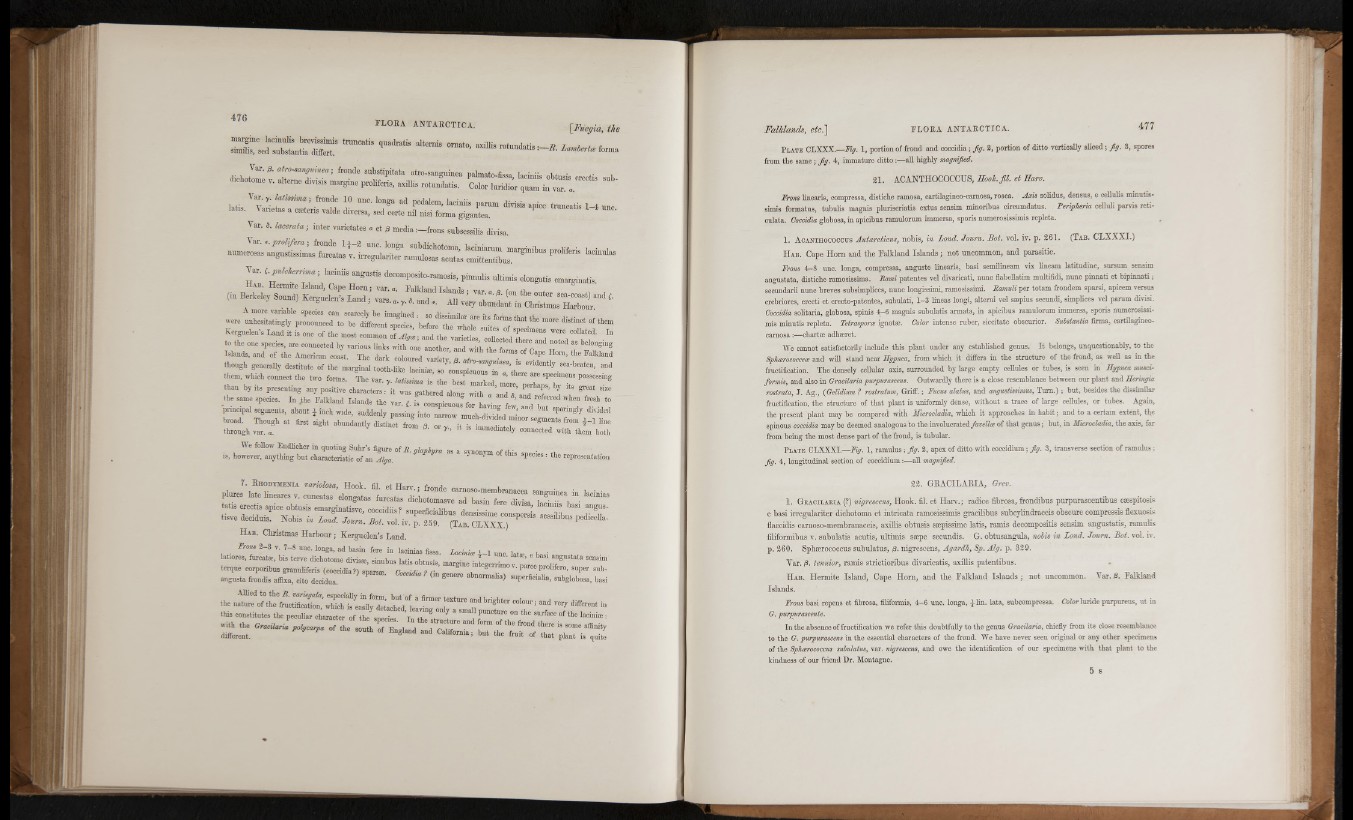
9? TI'
I* I
K i
\ ar. Ô. lacerata ; inter varietates >: et 3 media irons subsessilis dirisa.
l a r . laoiniis angustis decomposito-ramcsis, pinnulis ultimis elongatis emarginatis.
to the one species, are eonnected by various hnks with one another and with the fo
Islands, and of the American coast Tl.e d 1 i . “ "P“ Falkland
though generally destante 5
them, which connect the two forms. U e var. y. m ssim a is’ t h e l i r™ ” A T “P“™ ““® P°saeating
thau by its presenting any positive characters ■ it was fl, A h.V its great size
tbe same species. Iu Jhe Palklaud Islands the vai- t referred when fresh to
principal segments, about } inch wide suddenly passing sparingly dirided
broad. Though at first light a bm a d a Ì 5 5 1 1 1 “ i - segments from ^ -1 line
throngh var. „. ^ ' “ “ «hotely connected with them both
We follow Endlicher in quoting Suhr’s figure of A. glup/yra
IS, however, anything but characteristic of an Alga. synonym of this species : the representation
, i™ 1 .« I i . ™ ” r “ !r”i 2
H ab. Clmstmas Harbour ; Kerguelen’s Land.
s . t o t o t o t o t o s c ' : “ ' " i r : » ■■ “ *-■ ■■■ ■ “ — - -
terque corporibus grannliferis (coccidia9) sparsæ Coccidia ’ (in’ “ ‘“fl™ “ “ " ' P“™ Pilifero, super subangusta
frondis aftea, cito decidua. ‘ ® abnonnaba) superficialia, subglobosa, basi
the r " r
tlds constitutes the pecnbar cU a c te r f t o suec I t 7 1 1 surface of the laciniæ :
- t t e
Plate CLXXX,—Jfy. 1, portion of frond and coccidia ; fig. 2, portion of ditto vertically sliced ; fig. 3, spores
from the same ; fig. 4, immature ditto :—all highly magnifici.
2 1 . ACANTHOCOCCUS, H o o k .fil. et Haro.
Frons bnearis, compressa, distiche ramosa, cartllagmeo-camosa, rosea. Axis solidus, densus, e ceUuUs minutia-
simis formatas, tububs magnis pluriseriatis extus sensim minoribus circnmdatus. Feripheria celluli parvis reticulata,
Coccidia globosa, in apicibus ramulorum immersa, sporis numerosissimis repleta.
1. AcANTnococcus Antarcticus, n o b is, in Lond. Journ. Bot. vol. iv. p. 2 6 1 . (Ta b . CLXXXI.)
H a b . Cape Horn and th e Falkland Islands ; n o t uncommon, and parasitic.
Frons 4-8 unc. longa, compressa, anguste bnearis, basi semibneam vix lineam latitudine, sursum sensim
angustata, distiche ramosissima. Bami patentes vel divaricati, nunc flabellatim multifidi, nunc pinnati et bipinnati ;
secundarii nunc breves subsimpbces, nunc longissimi, ramosissimi. Famuli per totam frondem sparsi, apicem versus
crebriores, erecti et erecto-patentes, subulati, 1-3 bneas longi, alterni vel sæpius secundi, simpbces vel parum divisi.
CoccAia sobtaria. globosa, spinis 4-6 magnis subulatis armata, in apicibus ramulorum immersa, sporis numerosissimis
minutis repleta. Tetrasporæ ignotæ. Color intense ruber, siccitate obscmdor. Substantm firma, eartUagineo-
carnosa ;—chartæ adhæret.
We cannot satisfactorily include this plant under any established genus. I t belongs, unquestionably, to tbe
SpluerococcecB and will stand near Bypnea, from which it differs in the structnre of the frond, as well as in the
fructification. The densely cellular axis, surrounded by large empty cellules or tubes, is seen in Eypmea rnusd-
formis, and also in Gracilaria purpurascens. Outwardly there is a close resemblance hetween our plant and Heringm
rostrata, J. Ag., {Gelidium ? rostratum. Griff. ; Fucus alatus, and angustismnus. Turn.) ; but, besides the dissimilar
fructification, the structure of that plant is uniformly dense, without a trace of large cellules, or tubes. Again,
the present plant may be compared with Microcladia, which it approaches in habit ; and to a certain extent, the
spinous coccidia may be deemed analogous to the involucrated/arí//¿e of that genus ; but, in Microcladia, the axis, far
from being the most dense part of the frond, is tubular.
Plate CLXXXI.—-K/. 1, ramulus ; f g . 2, apex of ditto with coccidium ; fig. 3, transverse section of ramulus ;
fig. 4, longitudinal section of coccidium :—all magnified.
22. GEACILARIA, Grev.
1. G r acilaeia (?) nigrescens, Hook. fil. et Harv.; radice fibrosa, frondibus purpurascentibus cæspitosis
e basi irregulariter dichotoma et intricata ramosissimis gracilibus subcylindraceis obscure compressis flexuosis
flaccidis camoso-membranaceis, axiUis obtusis sæpissime latis, ramis decompositis sensim angustatis, ramulis
filiformibus V. subulatis acutis, ultimis sæpe secundis. G. obtusangnla, t e t/bwm. .B®/. vol. iv.
p. 260. Sphærococcus subulatus, /S. nigrescens, Agardh, Sp. Alg. p. 329.
Var. /3. tenuior, ramis strictioribus divaricatis, axillis patentibus.
H au. Hermite Island, Cape Horn, and th e I'alkland Is la n d s ; not uncommon. Var. Falkland
Islands.
Frons basì repens et fibrosa, filiformis, 4 -6 unc. longa, I lin. lata, subcompressa. Cb/or luride purpureus, ut in
G. purpurascente.
In the absence of fructification we refer this doubtfully to the genus Gracilaria, chiefly from its close resemblance
to the G. purpurascens in the essential characters of the frond. We have never seen original or auy other specimeus
of the Sphærococcus subulatus, var. nigrescens, and owe the identification of our specimeus with that plant to the
kindness of our friend Dr. Montagne.
5 s
I»
51 .
S . I
»